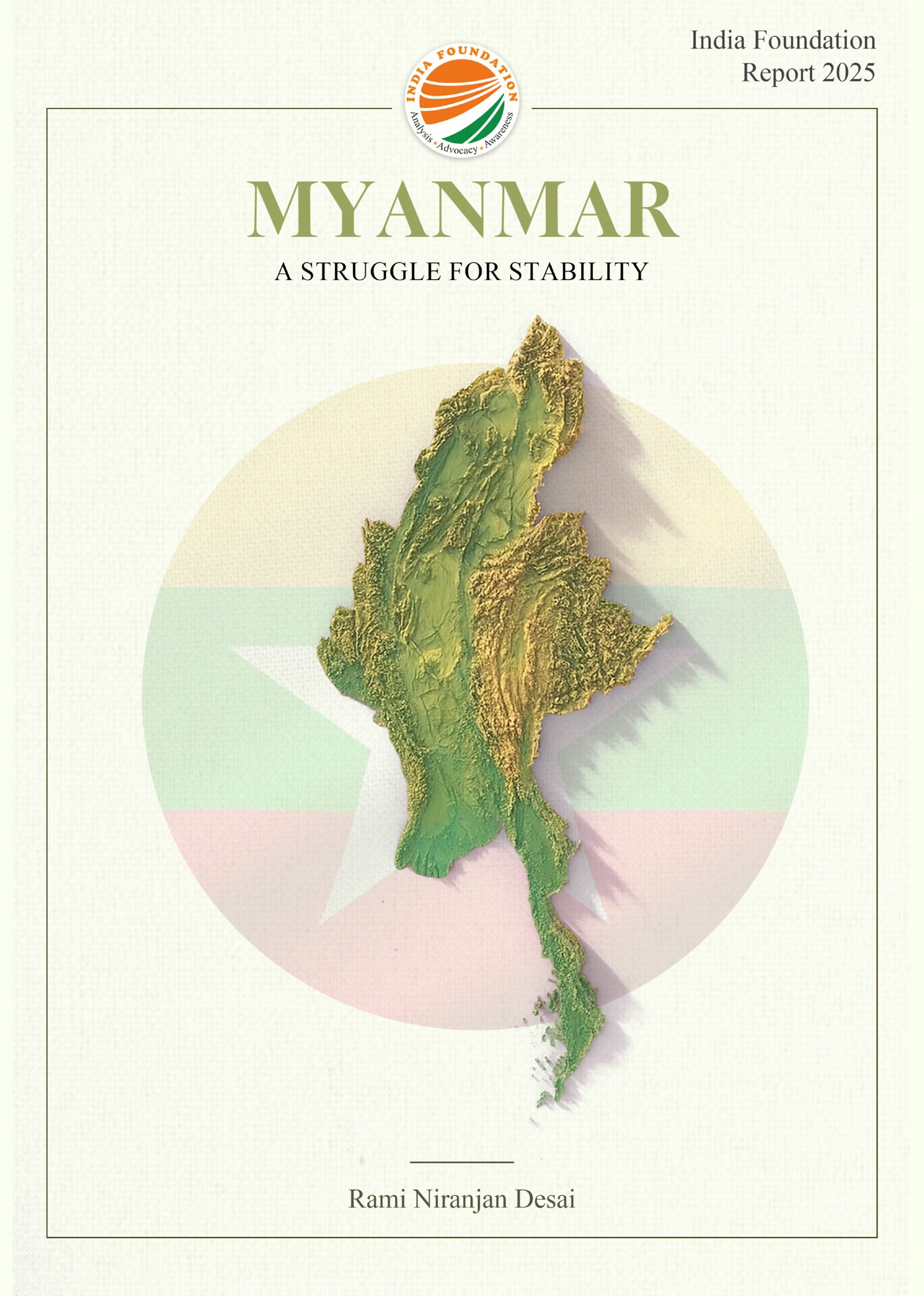The present time is colloquially being called the Asian Century for all the right reasons. If the 19th century was Britain’s Imperial century and the 20th was American, then the 21st century is becoming the Asian century. By 2020, the economic growth (in purchasing power parity terms) of Asian giants put together will surpass the rest of the world and that is likely to be the future trend as well.
The Indian Ocean Region (IOR) has played and continues to play a vital role in creating this Asian prosperity through the “road of development in the twenty-first century.” Today, the Indian Ocean has become a major conduit of international trade as it was until a few centuries back. While occupying almost 20 per cent of the earth’s surface, the IOR is inhabited by 35 per cent of the world’s population staying in 38 littoral states. Over 100,000 ships transit through the Indian Ocean every year, accounting for 66 per cent of the world’s oil cargo, 50 per cent of container cargo and 33 per cent of bulk cargo.[1] India’s 90 per cent trade by volume and 70 per cent trade by value is dependent on the Indian Ocean. The major fuel for growth for most of the Asian countries is oil. For the Asian countries, the supply of oil comes from West Asia—the Gulf region—while the major consumers, India, ASEAN, China, South Korea and Japan lie to the East. This oil, which fuels the growth of Asia is transported eastward from the Gulf via the Indian Ocean. The security of the production centres, as well as its transportation across the sea lanes, is thus vital for Asia and any disruption could put a huge question mark on the emergence of the 21st century as the Asian century. Oil thus is the most important governing factor of geopolitics these days andowing to its criticality the word “ge-oil-itics” needs to be introduced into common strategic parlance.
Asian economies have grown to be heavily dependent on oil imports to satisfy their growing demand. Crucially, Asian economies purchase most of this oil from the Gulf. As a share of oil imports, the Gulf region accounted for 44% of oil imports for China, 63.6% for India, 86% for Japan and 77.1% for South Koreaaccording to 2017 data compiled by the Observatory of Economic Complexity. Off late, some incidents impacting on oil security have exposed the vulnerability of Asian powers to events occurring in the Gulf. The mine attack, which blew of the hull of a Japanese oil tanker at a UAE port and 30 Indian sailors being detained by Iran who were on board a British tanker which was carrying the flag of Panama are cases in point.[2] But of even greater concern is the attack which took place on Saudi oil facilities on 14 September 2019. This attack has not received the attention it deserves, but if oil facilities continue to be targeted in the Gulf, the Asian century is unlikely to materialise any time soon.
The attack on Saudi oil facilities took place on 14 September through stealthy air attacks using drones and cruise missiles. The attack was claimed by the Houthi rebels in Yemen, but evidently, there are other powers behind the attack, using the Houthis as a front. This is a situation that should rightly be causing anxiety to both economists and strategic thinkers, but for some reasons, the danger signals are not being correctly read. If the conflict in Yemen escalates and spirals out of control, it would cripple the capability of Gulf oil suppliers and adversely impact the world economies, with the impact on the Asian economies being severely devastating. It is a matter of concern that as seen in the attack on the Saudi Aramco facilities, small budget precision aerial weapons could defeat heavily guarded installations of national importance. If it could happen in one of the heaviest guarded facilities in the world, then India needs to also pay attention to the security of its refineries (like Reliance refineries at our West coast). Attack on oil facilities will push up the price of oil which in turn will adversely impact India’s economy and will have the potential to dent India’s GDP growth rate. For example, according to Nomura, a Japanese financial holding company,an increase in oil prices by USD 10 per barrel will lead to a drop in India’s GDP by 0.2 per cent points.[3]
This attack by drones and cruise missiles has brought out the lethality and accuracy of Airpower while defeating another pillar of Airpower which is air-defence (detection, identification, timely interception and destruction). This is a lesson which Indian policymakers, strategists and tacticians must learn fast and evaluate India’s Airpower preparedness for this kind of attack from land or maritime borders.
Did it Happen Suddenly?
It took the world by shock when news of an attack on Saudi Oil installations in Abqaiq and Khurais hit the media channels. The undetected attacks carried out by unmanned aerial vehicles with high precision left people wonderstruck, especially as the attack was claimed by Houthi rebels. The sheer unexpectedness of such an attack being successfully mounted on a very heavily guarded facility by a small rebel force, albeit one that had external support, made some observers term the incident as a ‘Black Swan’ event. The attack disabled the largest crude processing facility of Saudi Arabia and disrupted Saudi oil supply capability by almost 50 per cent. The estimate was that the oil operations were down by 5.7 million barrels a day, which was approximately 5% of the daily global oil supply. James Rogers, a security expert with expertise in drones and a visiting research fellow at the Department of International Security Studies at Yale University, observed “It is quite an impressive, yet worrying, technological feat, long-range precision strikes are not easy to achieve and to cause the substantial fires in Abqaiq and Khurais highlights that this drone has a large explosive yield.”[4] It was a small budget attack by non-state actors (maybe state-sponsored) having strategic repercussions.WimZwijnenburg, a senior researcher on drones at a Dutch peace organisationanalysed it further saying, “The drones gave the Houthis an edge because they were cheap to produce, hard to detect and shoot down, and able to cause damage and disruption hugely disproportionate to their cost. While the Houthis’ exact capabilities are not known, they have developed over time.”[5]
Was this attack possible without thorough planning and practice? A timeline of recent attacks on Saudi targets claimed by Houthisshould prove the old proverb correct – ‘with practice comes perfection’. This timeline has been obtained from the article titled ‘Timeline: Houthis’ drone and missile attacks on Saudi targets’ published post the attacks on 14th September on the Aljazeera news platform.
- 5 January 2018: Saudi state-owned media saidthe kingdom’s defence forces intercepted a Houthi missile over the Najran province, on the southern border with Yemen, before it could hit its intended target. The rebel group claims responsibility for the attack, saying on Twitter it had a “successful launch of a short-range ballistic missile at a military target in Saudi Arabia”.
- 31 March 2018: Saudi Arabia said it intercepted a missile fired by the Houthis targeting the southern city of Najran.
- 24 June 2018: Saudi Arabia said its air defence forces intercepted and destroyed two Houthi ballistic missiles over Riyadh. At least six loud explosions were heard and bright flashes were seen in the sky over Riyadh. The Houthi-run Al Masirah TV said Burkan missiles were fired at the Saudi Ministry of Defence and other targets.
- 25 July 2018: Houthi rebels attacked a Saudi oil tanker in the Red Sea, causing slight damage, according to the Saudi-UAE-led coalition. The tanker was attacked in the west of Yemen’s Hodeidah port but the Houthis’ Al Masirah TV reported that the group targeted the Dammam warship off the western coast of Yemen.
- 9 August 2018: Saudi Arabia intercepted two missiles fired by the Houthis at its southern Jizan province, the official Saudi Press Agency quoted a military spokesman. Al Masirah TV said the Houthis fired several ballistic missiles at Saudi Arabia, targeting the border provinces of Jizan and Aseer.
- 3 April 2019: Coalition said it intercepted two drones launched by the Houthis towards the city of KhamisMushait.
- 14 May 2019: Saudi Arabia said armed drones struck two of its oil-pumping stations west of Riyadh. The Aramco East-West pipeline, stretching across the country to the port and oil terminal at Yanbu, was damaged in two places.
- 20 May 2019: The Saudi military said it shot down two ballistic missiles reportedly heading towards the cities of Jeddah and Mecca. The Houthis denied their missiles were targeting Mecca, a pilgrimage site some 70 kilometres from Jeddah and 50km from Taif. The group called to claim a tactic by Riyadh to rally support for its war.
- 12 June 2019: Houthi rebels fired a missile at Abha airport in southern Saudi Arabia, wounding 26 civilians in the building’s arrivals hall, according to the Saudi-UAE-led coalition. The coalition said a projectile hit the arrivals hall at Abha airport, causing material damage. Three women and two children were among the wounded.
- 17 June 2019: Houthi rebels launched a drone attack targeting Abhaairport, the group’s Al Masirah TV said. There was no immediate Saudi confirmation of the attack.
- 20 June 2019: The rebels hit a power station in Jizan province with a “cruise missile,” Al Masirah TV said. The coalition confirmed Houthi forces fired a “projectile” at a desalination plant in the al-Shuqaiq city but said no one was wounded and there was no damage caused to the facility.
- 2 July 2019: Another Houthi attack on Abha airport wounded nine civilians, the coalition said. The Houthis said they “launched a wide operation aimed at warplanes at Abha international airport” with drones, according to Al Masirah TV.
- 1 August 2019: Houthi rebels said they fired a long-range missile at the port city of Dammam in Saudi Arabia, hundreds of kilometres away from Yemen.
- 5 August 2019: Houthi forces launched drone attacks on Saudi Arabia’s King Khalid Airbase and Abha and Najran airports, according to a spokesman for the group. The spokesman said the attack on Abha airport “hit its targets” and air traffic was disrupted at both Abha and Najran. However, the coalition says the drones were intercepted and downed.
- 17 August 2019: A drone attackclaimed by the Houthis sparked a fire in a remote oil and gas field in eastern Saudi Arabia. A Houthi military spokesman said the group targeted the Shaybah oilfield with 10 drones, calling it the “biggest attack in the depths” of the kingdom. Saudi Aramco says the attack caused no casualties or disruption to production.
- 25 August 2019: The Houthis said theyfired 10 Badr-1 ballistic missiles at Jizan airport, killing and wounding dozens. The coalition said it intercepted and destroyed at least six ballistic missiles fired by the group targeting civilians in Jizan, in the southwest of the kingdom. It gave no details about casualties or damage.
- 26 August 2019: Houthi rebels claimed to have attacked a military target in Riyadh. According to a spokesman for the rebels, the attack was carried out with an armed drone. Saudi Arabia denied there was an attack by the Houthis.
- 10 September 2019: The coalition forces intercepted a drone over Yemen’s Saada province, Saudi Press Agency reported.
- 14 September 2019: Drone attacksclaimed by the Houthiscause fires at two major oil facilities run by Saudi Aramco.[6]
The reported 18 attacks before the most effective attack on 14 September simply tell that Houthis were progressing in both technology and intention to threaten the Saudi regime. All the previous attacks were carried out using aerial weapons like cruise missiles or drones. Hence Saudi security forces were well aware of the capability of the Houthi rebels and should have been better prepared to intercept the attack of 14 September. In any case, they should not have been taken by surprise. The features of this attack like well-chosen targets to cause maximum damage to Saudi reputation, deliberation on centres of gravity (CsOG) in the target system (crude oil stabilisers, natural gas storages), distance; direction and pattern (ultra lowlevel) and time chosen etc show that the planning was done by skilled air attack professionals.[7] Whosoever was behind this attack, one thing is clear; this did not happen all of a sudden. This was not a Black Swan event. This was a Grey Rhino event.[8]
This attack has brought out that non-state or state-sponsored non-state actors have acquired sophisticated systems that can impact the global economy and cause collateral damage of unprecedented nature. The threat in the Indian context is real with Pakistan sponsored non-state actors looking for opportunities to cause collateral damage within Kashmir and even across India. The drone attack can target high-value national leaders, critical infrastructure, power grid system, oil refineries, military installations and population centres. Drones are highly versatile and can deliver explosives, biological, chemical agents, and also act as the eyes and ears of the terrorists.[9] And this is not mere speculation because recently drones from Pakistani side have carried out missions of dropping weapons in Punjab. A large number of AK-47 assault rifles and grenades dropped in Amritsar by heavy-lifting drones that came from across the border, is speculated to be aimed at creating trouble in Jammu and Kashmir. The drones carried out eight ‘sorties’ in 10 days in the month of September to drop the weapons, including satellite phones. These flying machines with a capacity to carry up to 5 kg flew fast and low to evade detection.[10] Since then, activities of these drones have increased on India’s western borders and security forces are being put on alert. If one can see the similarities in the pattern of usage of drones by non-state actors against a state, it shall appear as the beginning of a larger plot against India. Indian security forces thus need to prepare to negate any such threats.
Safety of the Gulf
Presently, the US has a strong naval presence in the Gulf (and in IOR as well) and has traditionally safeguarded its energy security (including SLOCs) and that of its allies. However, its relative energy dependence on the countries of the region is diminishing with the exploitation of shale oil and gas at home front and it is no longer dependent on oil from the Gulf. However, the US continues to provide a security umbrella over the region, though it now seeks greater contribution from both India and China to contribute to the security architecture. During the last few years, discussions with the US have brought up the issue of India and China being free riders, depending upon American naval assets to protect their access to energy supplies from the Gulf without making any significant contribution themselves.[11]
The more worrisome fact is that none of the big Asian economies has vocally raised the level of concern on the deteriorating security environment in the Gulf. If the Saudi oil facilities can be attacked, so can the facilities of Iran, Iraq, the UAE, Kuwait and others. If such an eventuality were to occur, then the Asian economies would be crippled. The shy response of the four Asian powers surfaces the absence of any strategy in Asia’s capitals for dealing with security in the Persian Gulf if, or when, the Americans decide that they no longer want to get involved.[12] These four powers—India, China, Japan and South Korea are all heavily dependent on oil imports from the Gulf for meeting their energy requirements. While the latter three claim to have sufficient cushion of strategic reserves, India’s oil reserves are inadequate to cope with such turmoil in oil supply from western Indian Ocean Region and would place in jeopardy, India’s dream of becoming a USD five trillion economy by 2024. In all senses the future of geopolitics in the region will be controlled by “ge-oil-itics”.
The recent events in the Gulf should act as a wake-up call to India to review its role in the IOR in light of a reduced American presence and an ever-increasing Chinese footprint. It is thus time to strengthen India’s defence policy while focusing on an Air and Naval Power doctrine for maritime security. India’s maritime borders are exposed from three sides and there are many high-value assets located on Indian coastlines. Given the limited assets and constraints of the defence budget, conventional and non-conventional aerial threats can only be tackled through a rejuvenated Air-power philosophy focused on better integration of naval and air force assets. It would not only give India an insurance for its predicted economic rise but also give assurance to neighbouring IOR countries for mutual growth.
*Wing Commander Vikas Kalyani is Visiting Fellow at India Foundation. His area of research is defense and strategic studies. He is currently studying relations between India and IOR countries.
[1] Gupta Arvind, Whither Indian Ocean maritime order? 2016, pp-221
[2]HasanAlhasan, https://www.asiatimes.com/2019/09/opinion/big-asian-players-too-quiet-on-threats-to-gulf-security’
[3]HasanAlhasan, ibid
[4] Nada Altaher, Jennifer Hauser and Ivana Kottasová, Yemen’s Houthi rebels claim a ‘large-scale’ drone attack on Saudi oil facilities, https://edition.cnn.com/2019/09/14/middleeast/yemen-houthi-rebels-drone-attacks-saudi-aramco-intl/index.html September 15, 2019.
[5]Narender Kumar, https://www.vifindia.org/article/2019/october/01/saudi-arabia-drone-attack-sign-of-changing-character-of-hybrid-war, 15 Oct 19
[6] https://www.aljazeera.com/news/2019/09/timeline-houthis-drone-missile-attacks-saudi-targets-190914102845479.html accessed on 16 Oct 19
[7]First quoted by SumitMukerji, in a formal discussion organised by South Asian Institute for Strategic Affairs (SAISA) and Konrad-Adenauer-Stiftung at Nehru Memorial Museum and Library, New Delhi on 01 October 2019.
[8]First quoted by DhruvKatoch, Director, SAISA in a formal discussion organised by SAISA and Konrad-Adenauer-Stiftung at Nehru Memorial Museum and Library, New Delhi on 01 October 2019.
[9]Narender Kumar, https://www.vifindia.org/article/2019/october/01/saudi-arabia-drone-attack-sign-of-changing-character-of-hybrid-war, 15 Oct 19
[10]Mohammed Ghazali, https://www.ndtv.com/india-news/pakistani-drones-flew-low-dropped-weapons-in-8-sorties-in-punjab-say-sources-2106713, accessed on 16 Oct 19
[11]Shyam Saran, A Strategic Perspective, Whither India Ocean Maritime Order – 2016, pp 28
[12]HasanAlhasan, ibid



